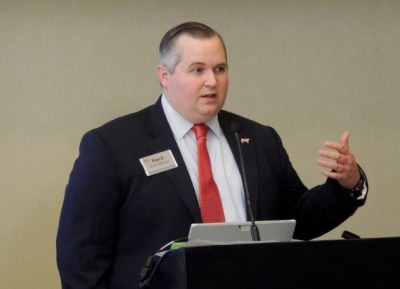U.S. beef exports to Japan have been very good in recent months — maybe too good.
The Japanese have imported so much U.S. beef, it’s looking like they will hit a “safeguard trigger” designed to protect domestic producers with a tariff.
If the U.S. exports more than 242,000 metric tons of beef to Japan in the Japanese fiscal year — April to March — the tariff on U.S. beef rises by more than 10 percentage points, shooting up from 25.8% to 38.5%. And the sooner that trigger is set off, the longer the tariff increase will be in place.
By Jan. 10 — a little over nine months into the Japanese marketing year — the U.S. had exported 203,721 tons of beef to Japan. That’s about 84% of the way toward the trigger, according to calculations by USDA’s Foreign Agricultural Service, leaving less than three more months with just a little over 16% of what is essentially a tariff rate quota left to fill.
“It’s something we’ll need to continue to monitor,” says Kent Bacus, director of international trade and market access for the National Cattlemen’s Beef Association. “I hope it’s something that can be avoided, but we are pretty close to hitting that (trigger).”
If the trigger is hit in February, the tariff on U.S. beef will increase for 45 days. If that happens in March, the tariff will increase for 30 days.
Either way, it will have a negative impact on U.S. beef exports, says Bacus.

Kent Bacus, NCBA
“It’ll be a temporary setback for us,” he told Agri-Pulse. “Obviously, when you raise the price on a hot commodity like beef in such a prolific market like Japan, that could have some temporary restrictions on our sales.”
U.S. Meat Export Federation economist Erin Borror said she is also concerned.
"Because the United States is the only beef supplier approaching its safeguard threshold, USMEF is concerned that chilled exports to Japan could decline if and when the snapback tariff rate is in place," she said. "This may include the weeks leading up to the 'Golden Week' holidays, a key time period for Japanese buyers."
Japan is the largest foreign market for U.S. beef, and U.S. exports, despite the logistical and demand problems caused by the COVID-19 pandemic, have been on track or better in 2020 than they were in 2019, according to data and analysis from the USMEF.
The U.S. exported 280,954 metric tons of beef to Japan — valued at about $1.8 billion — from January through November in 2020. Most of that trade (238,539 tons worth $1.4 billion) was in muscle cuts, according to USMEF.
But even if Japan’s safeguard tariff is triggered, there may be a way to stop Japan from implementing it.
U.S. negotiators convinced Japan to scrap its quarterly safeguard trigger in the free trade agreement that went into effect about a year ago. It was replaced with a yearly mechanism believed to be much less of a threat to disrupting trade, but that may still happen unless the two sides agree to renegotiate — an option made possible by a provision tucked into a side letter of the U.S.-Japan Trade Agreement.
Japan, according to the Office of the U.S. Trade Representative, agreed “to consult to adjust the applicable safeguard trigger level to a higher level if the safeguard is ever triggered.”
Bacus said that if the safeguard tariff is triggered, those consultations will need to happen.
“These are conversations that we’ll need to have so our governments can figure out the best path forward,” he said. “This is something we need to pursue because it’s overwhelmingly clear that Japanese consumers want more U.S. beef.”
It is unclear how long it would take to set up those consultations between the U.S. and Japan, and what the result would be.
Regardless, the safeguard tariff would only be temporary and won’t stop U.S. beef, says Bacus.
“I think the important thing to keep in mind is that the safeguard — if it is triggered — would be temporary,” he stressed. “But it’s also just another signal of how strong our sales are in Japan and how much the Japanese consumers prefer the great American beef that we produce.”
That’s not to say that the U.S. beef sector does not want a bigger quota for U.S. beef. The Japanese quota for members of the Comprehensive and Progressive Agreement for Trans-Pacific Partnership (CPTPP), which includes Australia, is bigger at 613,600 tons for the Japanese fiscal year.
The U.S. quota is set to begin growing by 4,860 tons per year, beginning in the 2023 Japanese fiscal year for the following six years.
Nevertheless, expanding the quota for U.S. beef is something both countries are “going to have to revisit,” Bacus said.
But the Japanese government has become increasingly concerned about too much imported beef hitting the Japanese market, according to a new analysis by USDA’s Foreign Agricultural Service.
Japan’s Agriculture and Livestock Industries Corporation, a state trading enterprise, began offering on Jan. 1 to pay importers to freeze the more expensive chilled cuts of beef they bring into the country. The government organization is willing to spend the equivalent of $14.2 million to pay importers “to fill the price gap between chilled and frozen products given the deterioration in quality due to freezing” in order to “stabilize beef demand and supply in Japan due to potential demand declines as a result of COVID-19.”
For more news, go to www.Agri-Pulse.com.
"danger" - Google News
January 27, 2021 at 07:23PM
https://ift.tt/3t13DIH
US beef exports in danger of triggering Japanese tariff - Agri-Pulse
"danger" - Google News
https://ift.tt/3bVUlF0
https://ift.tt/3f9EULr
No comments:
Post a Comment